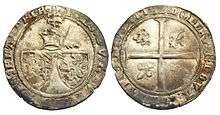John the Fearless
| John the Fearless | |
|---|---|
 | |
| Duke of Burgundy | |
| Reign | 27 April 1404–10 September 1419 |
| Predecessor | Philip the Bold |
| Successor | Philip the Good |
| Born |
28 May 1371 Dijon, France |
| Died |
10 September 1419 (aged 48) Montereau, France |
| Burial | Dijon, Burgundy |
| Spouse | Margaret of Bavaria |
| Issue |
|
| House | Valois-Burgundy |
| Father | Philip the Bold |
| Mother | Margaret III, Countess of Flanders |
John the Fearless (French: Jean sans Peur, Dutch: Jan zonder Vrees), also known as John of Valois and John I of Burgundy (28 May 1371 – 10 September 1419), was Duke of Burgundy from 1404 to 1419. He was a member of the Burgundian branch of the Valois Dynasty. For a period of time, he served as regent of France on behalf of his first cousin King Charles VI of France, who was severely mentally ill.
Biography
Early life
.svg.png)


| Duchy of Burgundy- House of Valois, Burgundian Branch |
|---|
 |
| John the Good |
| Philip the Bold |
| John the Fearless |
| Philip the Good |
|
| Charles the Bold |
|
| Mary of Burgundy |
John was born in Dijon on 27 May 1371 to Philip II "the Bold," Duke of Burgundy, and Margaret III, Countess of Flanders. On the death of his maternal grandfather Louis II, Count of Flanders, in 1384, he received the title Count of Nevers, which he bore until his father’s death in 1404,[1] when he ceded it to his brother Philip.
In 1385,[1] a double wedding for the Burgundian family took place in Cambrai. John married Margaret of Bavaria, daughter of Albrecht of Bavaria, Count of Holland and Hainaut,[1] while at the same time his sister Margaret of Burgundy married Albrecht's son William in order to consolidate John's position in the Low Countries. The marriage took place after John cancelled his engagement to Catherine of France, a daughter of King Charles V of France who was only a child at the time.
Before his accession to the Duchy of Burgundy, John was one of the principal leaders of the French forces sent to aid King Sigismund of Hungary in his war against Sultan Bayezid I. John fought in the Battle of Nicopolis of 25 September 1396 with such enthusiasm and bravery that he was given the cognomen Fearless (Sans-Peur). Despite his personal bravery, his impetuous leadership ended in disaster for the European expedition.[2] He was captured and did not recover his liberty until the next year after an enormous ransom was paid.[1]
Conflict with Louis of Orléans



John was invested as Duke of Burgundy in 1404 upon the death of his father Philip the Bold and almost immediately entered into open conflict with Louis, Duke of Orléans, the younger brother of the increasingly disturbed King Charles VI of France. Both men attempted to fill the power vacuum left by the demented king.[1]
John played a game of marriages by exchanging his daughter Margaret of Burgundy for Michelle of Valois, who would marry his heir, Philip the Good. For her part, Margaret was married to Louis, Duke of Guyenne, the heir to the French throne from 1401 until his death in 1415. For all his concentration on aristocratic politics, John nonetheless did not overlook the importance of the middle class of merchants and tradesman or the University of Paris.[1]
Louis tried to gain the favour of the wife of Charles VI, Queen Isabeau of France, and may have become her lover. After his son-in-law, the Dauphin Louis, was successively kidnapped and recovered by both parties, the Duke of Burgundy managed to gain appointment by royal decree — during one of the King's "absent" periods when mental illness manifested itself — as guardian of the Dauphin and the King's children. This did not improve relations between John and the Duke of Orléans. Soon the two rivals descended into making open threats. Their uncle, John, Duke of Berry, secured a vow of solemn reconciliation on 20 November 1407, but only three days later, on 23 November 1407, Louis was brutally assassinated in the streets of Paris.[1] The order, no one doubted, had come from the Duke of Burgundy, who shortly admitted to the deed and declared it to be a justifiable act of "tyrannicide". According to Thomas Walsingham, Orléans had simply received his just deserts as he had been "taking his pleasure with whores, harlots, incest" and had committed adultery with the wife of an unnamed knight who had taken his revenge by killing him under the protection of the Duke of Burgundy. After an escape from Paris and a few skirmishes against the Orléans party, John managed to recover the King's favour. In the treaty of Chartres, signed on 9 March 1409, the King absolved the Duke of Burgundy of the crime, and he and Louis' son Charles pledged a reconciliation. A later edict renewed John's guardianship of the Dauphin.[1]
Even with the Orléans dispute resolved in his favour, John did not lead a tranquil life. Charles, the son and heir of the murdered Duke of Orleans, was only 14 at the time of his father's death and was forced to depend heavily on allies to support his claims for the property that had been confiscated from him by the Duke of Burgundy. Chief among these allies was his father-in-law Bernard VII, Count of Armagnac. Because of this alliance, their faction became known as the Armagnacs in opposition to the Burgundians. With peace between the factions solemnly sworn in 1410, John returned to Burgundy and Bernard remained in Paris, where he reportedly shared the Queen's bed. The Armagnac party was not content with its level of political power, and after a series of riots and attacks against the citizens, John was recalled to the capital, then sent back to Burgundy in 1413. At this time, King Henry V of England invaded French territory and threatened to attack Paris. During the peace negotiations with the Armagnacs, Henry was also in contact with John, who was keen to wrest control of France away from King Charles VI. Despite this, he continued to be wary of forming an alliance with the English for fear of destroying his immense popularity with the common people of France. When Henry demanded Burgundy's support for his claim to be the rightful King of France, John backed away and decided to ally himself with the Armagnacs. Although he talked of helping his sovereign, his troops took no part in the Battle of Agincourt in 1415, although two of his brothers, Antoine, Duke of Brabant, and Philip II, Count of Nevers, died fighting for France during the battle.[1]
Conflict with the Dauphin

Two years later, with the rivalry between Burgundians and Armagnacs at an all-time high because of the shattering defeat at Agincourt, John's troops set about the task of capturing Paris. On 30 May 1418, he did capture the city, but not before the new Dauphin, the future Charles VII of France, had escaped. John then installed himself in Paris and made himself protector of the King. Although not an open ally of the English, John did nothing to prevent the surrender of Rouen in 1419. With the whole of northern France in English hands and Paris occupied by Burgundy, the Dauphin tried to bring about a reconciliation with John. They met in July and swore peace on the bridge of Pouilly, near Melun. On the grounds that peace was not sufficiently assured by the meeting at Pouilly, a fresh interview was proposed by the Dauphin to take place on 10 September 1419 on the bridge at Montereau. John of Burgundy was present with his escort for what he considered a diplomatic meeting. He was, however, assassinated by the Dauphin's companions. He was later buried in Dijon. His successor Philip the Good formed an alliance with the English.[1]
Ancestry
| Ancestors of John the Fearless |
|---|
|
|
Family
John and his wife Margaret, who married in 1385, had one son, who succeeded him, and seven daughters:[1]
- Catherine (1391–1414, Ghent), promised in 1410 to a son of Louis of Anjou;[1]
- Marie (1393 – 30 October 1463, Monterberg bei Kalkar). She married Adolph I, Duke of Cleves;[1]
- Margaret (1394 – 2 February 1441, Paris), married on 30 August 1404 Louis of Valois the Dauphin (heir of king Charles VI of France), then in 1423 Arthur de Richemont, the future Duke of Brittany;[1]
- Philip (1396–1467) son and heir;[1]
- Isabelle[1] (d. 18 September 1412, Rouvres), married at Arras on 22 July 1406 to Olivier de Châtillon-Blois, Count of Penthièvre and Périgord;[1]
- Joanna[1] (b. 1399, Bouvres), died young;
- Anne (1404 – 14 November 1432, Paris), married John, Duke of Bedford;[3]
- Agnes (1407 – 1 December 1476, Château de Moulins), married Charles I, Duke of Bourbon.[1]
John and his mistress Agnes de Croy, daughter of Jean I de Croÿ, had the following child:[4]
John and his mistress Marguerite de Borsele had the following children:[5][6]
- Guy of Burgundy, Lord of Kruybeke (killed in battle Calais 1436), married Johanna, illegitimate daughter of Albert I, Duke of Bavaria.[7][6]
- Antoine of Burgundy.[8]
- Philipotte of Burgundy, Lady of Joncy, married Antoine of Rochebaron, Baron of Berze-le-Chatel.[5][7]
Titles
-
 1384–1404: Count of Nevers as John I
1384–1404: Count of Nevers as John I -
 27 April 1404–10 September 1419: Duke of Burgundy as John I
27 April 1404–10 September 1419: Duke of Burgundy as John I -
 21 March 1405–10 September 1419: Count Palatine of Burgundy as John I
21 March 1405–10 September 1419: Count Palatine of Burgundy as John I -
 21 March 1405–10 September 1419: Count of Artois as John I
21 March 1405–10 September 1419: Count of Artois as John I -
 21 March 1405–10 September 1419: Count of Flanders as John I
21 March 1405–10 September 1419: Count of Flanders as John I -
 27 April 1404–28 January 1405: Count of Charolais as John I
27 April 1404–28 January 1405: Count of Charolais as John I
See also
Notes
- 1 2 3 4 5 6 7 8 9 10 11 12 13 14 15 16 17 18 19 Poupardin 1911, p. 445.
- ↑ Smith & DeVries 2005, pp. 71–73.
- ↑ Library of Congress staff 2014.
- ↑ Vaughan 2005, p. 236.
- 1 2 Sommé 1998, p. 69.
- 1 2 Kasten 2008, p. 478.
- 1 2 Vaughan 2005, p. 134.
- ↑ Kerrebrouck 1990, p. 157.
References
- Kasten, Brigitte (2008). Herrscher- und Fürstentestamente im westeuropäischen Mittelalter. Böhlau Verlag Köln Weimar. p. 478.
- Kerrebrouck, Patrick van (1990). Nouvelle histoire généalogique de l'auguste maison de France Les Valois. 3. Villeneuve-d'Arcy. p. 517.
- Library of Congress staff (16 December 2014) [2011]. "Library of Congress Name Authority File: Anne, of Burgundy, Duchess of Bedford, 1404?-1432".
- Smith, Robert Douglas; DeVries, Kelly (2005). The artillery of the Dukes of Burgundy, 1363-1477. pp. 71–73.
- Sommé, Monique (1998). Isabelle de Portugal, duchesse de Bourgogne une femme au pouvoir au XVe siècle. Presses universitaires du Septentrion. p. 69.
- Vaughan, Richard (2005). John the Fearless The Growth of Burgundian Power. 2. Boydell Press.
Attribution
 This article incorporates text from a publication now in the public domain: Poupardin, René (1911). "John, Duke of Burgundy". In Chisholm, Hugh. Encyclopædia Britannica. 15 (11th ed.). Cambridge University Press. pp. 445–446.
This article incorporates text from a publication now in the public domain: Poupardin, René (1911). "John, Duke of Burgundy". In Chisholm, Hugh. Encyclopædia Britannica. 15 (11th ed.). Cambridge University Press. pp. 445–446.
External links
| Wikimedia Commons has media related to John the Fearless. |
- Jean sans Peur/John the Fearless
- Tour Jean-sans-Peur (in French)
- One of John the Fearless' rings (in French)
| John the Fearless Cadet branch of the House of Valois Born: 28 May 1371 Died: 10 September 1419 | ||
| Preceded by Philip the Bold |
Duke of Burgundy 27 April 1404 – 10 September 1419 |
Succeeded by Philip the Good |
| Count of Charolais 27 April 1404 – 28 January 1405 | ||
| Preceded by Margaret III & II |
Count of Artois and Flanders Count Palatine of Burgundy 21 March 1405 – 10 September 1419 | |
| Count of Nevers 1384–1404 |
Succeeded by Philip II | |
